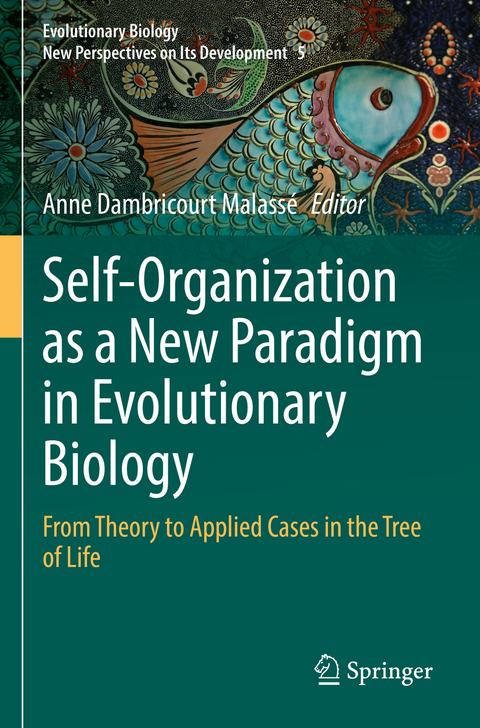
Self-Organization as a New Paradigm in Evolutionary Biology
Springer International Publishing (Verlag)
978-3-031-04785-5 (ISBN)
The epistemological synthesis of the various theories of evolution, since the first formulation in 1802 with the transmission of the inherited characters by J.B. Lamarck, shows the need for an alternative synthesis to that of Princeton (1947). This new synthesis integrates the scientific models of self-organization developed during the second half of the 20th century based on the laws of physics, thermodynamics, and mathematics with the emergent evolutionary problematics such as self-organized memory.
This book shows, how self-organization is integrated in modern evolutionary biology. It is divided in two parts: The first part pays attention to the modern observations in paleontology and biology, which include major theoreticians of the self-organization (d'Arcy Thompson, Henri Bergson, René Thom, Ilya Prigogine). The second part presents different emergent evolutionary models including the sciences of complexity, the non-linear dynamical systems, fractals, attractors, epigenesis, systemics, and mesology with different examples of the sciences of complexity and self-organization as observed in the human lineage, from both internal (embryogenesis-morphogenesis) and external (mesology) viewpoints.
lt;p>Anne Dambricourt Malassé (PhD 1987 in paleoanthropology, Accreditation to Supervise Research 2011) is born in 1959 at Neuilly-sur-Seine (France). She is researcher at the National Center for Scientific Research (CNRS) and attached to the National Museum of Natural History (NMNH), Paris, since 1990. The research center is housed by the Institute of Human Paleontology, a Foundation Albert 1st Prince of Monaco (1910). Her research has been focusing more than 30 years to the evolution of the face and the skull base in the human lineage. She has put in light their morphodynamic links in relation to the neural crest cell migration, the bending of the chondrocranium and the straightening of the neural tube, i.e. the verticalization of the cranio-caudal axis. This new approach opened human paleontology to the sciences of complexity and nonlinear dynamic systems, the mathematical modelling of unstable systems and the homeotic genes. Her dynamical and geometrical approach was strongly supported by René Thom (Fields Medal) and has important repercussions in dento-maxillo-facial orthopedics and posturology. She has been teaching since 1990 at the postgraduate level (NMNH, René Descartes University, Aix-Marseille University) and has supervised more than 40 predoctoral (French DEA) and doctoral theses. Since 2007, she has conducted seminars in prehistory and paleoanthropology at the Doctoral School of NMNH. More than 20 years of fieldworks in Pakistan then in India, have led her to the discovery of the oldest human activities in Asia, in the Indian Sub-himalayan piedmonts (butchery and stone tools making activities dated to 2.8 Ma). She is currently leading the program "Siwaliks" with two Research Units of the CNRS, the "Natural history of prehistoric Man" laboratory, NMNH and the "Geosciences" laboratory of Paris-Saclay University. She has initiated and co-founded the association FREHOPS, "Research Federation on Human Evolution, Osteopathy and Posture to Serve Health".
Chapter 1: Introduction: Understanding the Origins and Evolution of Living Organisms. The Necessity of Convergence Between Old and New Paradigms.- Part I: The Modernity of Old Paradigms.- Chapter 2: Self-Organization Meets Evolution: Ernst Haeckel and Abiogenesis.- Chapter 3: D'Arcy Thompson on Form and Intrinsic Purposiveness: Contributions to Epigenetic and Autopoietic Theory.- Chapter 4: From Dissipative Structures to Biological Evolution: A Thermodynamic Perspective.- Chapter 5: Evolutionary Transformations of Body Plan in Metazoa: Self-Organization, Topological Transformations, and Genomic-Morphogenetic Correlations.- Chapter 6: The Challenge of Bergson, Instinct as Form.- Part II: Modernity of Self-Organization and Emerging Paradigms.- Chapter 7: Biological Evolution of Microorganisms.- Chapter 8: Self-Organization in Embryonic Development: Myth and Reality.- Chapter 9: The Morphoprocess and Diversity of Evolutionary Mechanisms of Metastable Structures.- Chapter 10: Mesological Plasticity as a New Model to Study Plant Evolution, Interactive Ecosystems and Self-organized Evolutionary Processes.- Chapter 11: Thermal Worm Model to Describe Log-Periodicity in the Tree of Life.- Chapter 12: Sapiens and Cognition: The Optimal Vertical Nervous System. The Last Primate Threshold of Self-Organized and Self-Memorizing Increasing Complexity from Gametes to Embryo.- Chapter 13: Evolutionary Creativity.
| Erscheinungsdatum | 07.07.2023 |
|---|---|
| Reihe/Serie | Evolutionary Biology – New Perspectives on Its Development |
| Zusatzinfo | VI, 393 p. 82 illus., 48 illus. in color. |
| Verlagsort | Cham |
| Sprache | englisch |
| Maße | 155 x 235 mm |
| Gewicht | 611 g |
| Themenwelt | Naturwissenschaften ► Biologie ► Evolution |
| Schlagworte | abiogenesis • Attractors • Embryogenesis • epigenesis • epistemological synthesis • evolutionary transformations • Fractals • mesology • Morphogenesis • Non-linear Dynamical Systems • Self-Organization • systemics |
| ISBN-10 | 3-031-04785-0 / 3031047850 |
| ISBN-13 | 978-3-031-04785-5 / 9783031047855 |
| Zustand | Neuware |
| Informationen gemäß Produktsicherheitsverordnung (GPSR) | |
| Haben Sie eine Frage zum Produkt? |
aus dem Bereich


